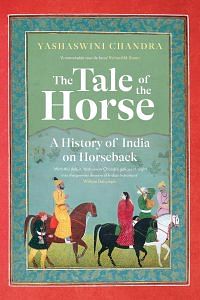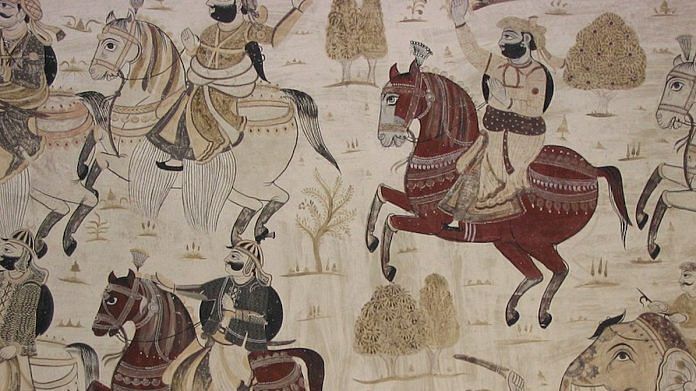While the great epic poems of ancient India, the Ramayana as well as the Mahabharata, bear testimony to the emergence of the horse from the ocean, another origin myth that has stood the test of time chronicles the descent of horses from the heavens. The legend identifying horses as originally winged celestial creatures is mainly preserved within the Shalihotra or Ashvashastra (the discipline of the horse) genre of Indian literature.
In most versions of the myth, the celestial progenitors of the horse lost their wings at the hands of Shalihotra. Eager to do Indra, the king of gods, a good turn, he clipped their wings so they could pull Indra’s chariot and serve in his army. In another iteration of the legend, they were mischievous and wild, managing to irritate Indra, who tore off their wings and banished them forevermore to earth. Thus, the horse appeared from both the ocean and the heavens, and it is as if these two myths allude to two of the main arenas from where horses arrived in India. Through much of the history of the subcontinent, horses sailed across the Arabian Sea from the Middle East while also travelling overland from Central Asia, where the earth is said to meet the sky and soar towards heaven.
But before different parts of India fell into a pattern of importing horses as well as producing their own, the subcontinent began on an almost clean slate. The native population of wild horses had disappeared by 8000 BCE, and it was only the ancestors of the Indian wild ass or ghor khar, particularly associated with northwestern and western India, that survived. The infusion of horses since then can be ascribed to the Indo-Aryans, speakers of an Indo-European language that evolved into Sanskrit, who migrated to the subcontinent from the north and the west in waves from circa 1500 BCE.
There is limited evidence of the horse from the earlier, Bronze Age, Harappan or Indus valley civilization. Many of the famous terracotta seals to be recovered from Harappan sites are engraved with various animals, but there is no sign of the horse. A few remains such as terracotta toys and figurines, teeth and bone fragments which could be identified with horses have done little to dispel the view that horses were hardly available or domesticated until the late Harappan phase. Any traces of the horse from the later period could have been an outcome of early rounds of migration or an older history of the commingling of the peoples of Harappa, Central Asia and Iran/Persia. Recent excavations at Sanauli in Uttar Pradesh have yielded three chariots with solid wheels dated to 2000–1800 BCE, which might have been pulled by horses.
Also read: Art to sacrifices: How the horse became important in 18th century India
While these findings may shed new light on the matter, the scholarly discourse locating them within the context of the Indian Bronze Age is still evolving. The picture becomes clearer with the Indo-Aryans, since it is well known that the horse and the horse-drawn chariot with spoked wheels were integral to their way of life in India. By the time the Indo-Aryans began their migrations into the subcontinent, the Harappan civilization was in decline, coming to a slow and protracted end across its large expanse. Using horses and chariots as their main means of transport and war, the Indo-Aryans spread across north India and established themselves.
The greatest achievement of the Indo-Aryans, since their equine contributions, was the composition of the Vedas, four compendiums of hymns and incantations, considered the oldest Hindu texts. This was also the beginning of an outpouring of ancient scriptures and epic poetry, which were transmitted orally before they were all written up and codified, becoming the basis for the Vedic religion and, subsequently, Hinduism.
The oldest, the Rig Veda, itself attests to the cultic importance of horses to ancient Indian culture. It might surprise us to find that the horse is mentioned in it 215 times, thirty-nine times more than the cow, which has come to be widely revered in India. The hymn to arms depicts the horse as a vital component of the Vedic martial ethos and brings alive classical scenes of heroic warriors hurtling forth in horse-drawn chariots. It idealizes the warrior chief: ‘His face is like a thundercloud, when the armoured warrior goes into the lap of battles.’ It eroticizes his bow, comparing it to a female companion: ‘She comes all the way up to your ear like a woman who wishes to say something, embracing her dear friend; humming like a woman, the bowstring stretched tight on the bow carries you safely across the battle.’ It extols the horses drawing his chariot: ‘Neighing violently, the horses with their showering hoofs outstrip everyone with their chariots. Trampling down the foes with the tips of their hoofs, they destroy their enemy without veering away.’ The hymn was recited by priests to bring down blessings on the heads of warriors at the onset of battle or the equally fearsome ashvamedha yajna or horse sacrifice, which encapsulates the ritualistic significance of the horse. The ultimate royal ceremony performed by the greatest of kings, the ashvamedha yajna was believed to ensure the sanctity of their rule and is immortalized in both the Ramayana and the Mahabharata.
Considering all the different rules, rituals and preparations relating to the sacrifice that came to be listed in the Dharmashastra texts, it is not surprising that it was rarely conducted even in ancient times. Elaborate as it was, the exercise culminated with the sacrifice of a horse especially selected for the purpose. The sacrificial animal had to be all white and fast, much like the mythical Uchchaishravas. The reference to dark spots and patches suggests that a piebald or skewbald horse was also acceptable for its striking appearance. Or it had to sport a mane that appeared midnight blue. It should have been allowed to wander about for a year accompanied by a complement of four hundred of the king’s men, including a hundred royal princes. They were required to guard the consecrated animal and defend its right to stray into the territories of other kings, over whom their lord could now claim suzerainty. The sacrifice was performed on a ground soaked with the blood of the masses of different domestic animals previously slaughtered there in preparation for the final act.
Also read: Aryans did not invade India or destroy the Indus Valley Civilisation. This is proof
Various methods seem to have been adopted to execute the horse. It would have had to be restrained by two men as it was killed by the executioner. It might also have been strangled to hasten its death. The chief queen had to perform a particularly lurid role, obligated to lie beside the dead horse under a covering in an act of uniting with the animal – symbolically, if not in the actual sense. Needless to say, the horse could not have known that, sacrificed in this gory way, he was supposedly destined for heaven to beseech the gods to shower the king with blessings and expiate his sins. ‘You do not really die through this, nor are you harmed. You go to the gods on paths pleasant to go on . . . Let this racehorse bring us good cattle and good horses, male children and all-nourishing wealth. Let Aditi free us from sin [including the sin of killing the horse]. Let the horse with our offerings achieve sovereign power for us.’
The horse as a motif would only grow in profile and find different forms and meanings across a range of regional traditions, the process coinciding with the rise of the horse also as a weapon of war.
Chariots were a fixture on the battlefields of India until the beginning of the Common Era, overturned by the seventh century, after horses had come to be ridden into war. The cavalry was a vital arm of the forces of India’s first great empire, ruled by the Mauryan dynasty, which lasted from the early fourth to the late second century BCE. It is from this period that we get an idea of the major centres of horse breeding and the trade in horses from distant lands.
 This excerpt from ‘The Tale of the Horse: A History of India on Horseback’ by Yashaswini Chandra has been published with permission from Picador India, an imprint of Pan Macmillan.
This excerpt from ‘The Tale of the Horse: A History of India on Horseback’ by Yashaswini Chandra has been published with permission from Picador India, an imprint of Pan Macmillan.




Aryan story is a fabricated, fake story created by some Westerners who were jealous and couldn’t accept the greatness of Indian history/culture/technology.
care to write an article on the number of rapes by these mughlals